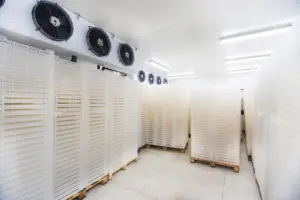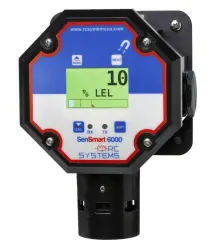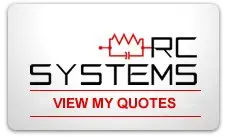Ammonia Gas Detectors
Ammonia gas detectors are an essential part of workplace safety because the strong-smelling ammonia gas can become toxic when exposed to air. Continuous monitoring of ammonia concentration in the air lessens the risk of skin, eye, nose, and throat irritation and may even help prevent respiratory failure.
Ammonia(NH3)Gas Detectors, Monitors and Alarm Controllers
Fixed Gas Detector Solutions for Monitoring Ammonia Gas Levels
RC Systems has been a global leader in fixed gas detection and alarm control since 1989. Our SenSmart line of ammonia gas detectors and sensors provide the price/performance ratio and versatility to fit any situation. SenSmart ammonia (NH3) gas detectors and monitors offer important features including sensor heater (SenSmart 5100 & 6100) for low-temperature applications such as ammonia refrigeration, Ethernet with embedded Web Server (SenSmart 6100), and wireless ammonia monitoring with the easy to install SenSmart 7100. Our SenSmart 1100 and SenSmart 4100 4-20mA loop-powered ammonia (NH3) gas detectors and monitors offer the same reliability, but at a lower price point.

Need Help Selecting an Ammonia Leak Detector?
Selecting the correct sensor for your application can be confusing. The professionals at RC Systems have years of experience monitoring ammonia and other toxic gases. Please reach out to us for help selecting the best SenSmart products for your specific application.
Sensors for Ammonia Monitoring Applications
- SenSmart 1100 - Low power and cost-effective, the SenSmart 1100 provides a convenient 4-20mA output
- SenSmart 4100 - Loop-powered, cost-effective solution that features a graphical display
- SenSmart 5100 - Adds a backlight to the display and the ability to add Modbus RTU and relays for local alarming
- SenSmart 6100 - Our top-of-the-line wired ammonia gas detector. Features a colored display, standard Ethernet port with an embedded webpage, and enhanced Smart Sensor capabilities
- SenSmart 7100 - Our state-of-the-art wireless ammonia gas detector that can be powered via battery or 10-30VDC power; providing unparalleled versatility and ease of deployment as part of our WaveNet System
Proper Ammonia Gas Sensor Placement for Effective Gas Detection
Proper placement of the ammonia gas sensor is important for it to be effective. Since ammonia gas is lighter than air, it will typically rise to the ceiling when it is released. Placing ammonia gas sensors at ceiling height will help ensure that leaks are detected before they reach dangerous levels. If they are placed too low in the room, the ammonia gas sensors will take much longer to detect the gas, allowing it to accumulate and cause respiratory irritation.
When installing ammonia gas sensors for fixed gas detection, it is important to avoid placing the detectors near windows, vents, or fans. Installation near drafts or circulating air will prevent the sensor from getting an accurate reading, making the device less effective. Humidity and temperature are also important, as hot or humid conditions can affect the accuracy of readings. If your operating environment is humid or the ammonia gas sensor will be exposed to high temperatures, the use of protective heat shields may be required.
For an effective ammonia detection system, you also need to have enough sensors to provide enough coverage for your room size. Our experts can help you determine how many ammonia gas sensors you need based on your facility size, ammonia equipment size, and type of sensor selected.

The Importance of Maintaining Your Ammonia Gas Monitors for Effective Gas Detection
Ammonia gas sensors should be tested monthly, at a minimum, to ensure they are functioning properly. These tests, known as bump tests, involve briefly exposing the sensor to ammonia gas to see if it responds. If the ammonia gas sensor does not trigger an alarm after exposure, the device will need to be calibrated. To calibrate the anomia gas sensor, the device is subjected to prolonged exposure to ammonia gas. During this time, the readings provided by the sensor are monitored to ensure accuracy.
The date the testing took place, as well as the results, should be recorded as part of your fixed gas detection preventative maintenance plan. Maintenance and calibration can be performed by a facility manager, or by a local RC Systems gas detection expert. Contact our support team to learn more about monitoring ammonia levels at your facility or about our calibration gases, kits and accessories.
Ammonia Gas Sensors, Monitors and Alarm Controllers
RC Systems provides a wide range of ammonia gas sensors, detectors, and alarm controllers that can be configured based on your requirements. Our products are designed for fixed gas detection applications and come with full installation and maintenance support from our experts. We also recommend keeping spare sensors on hand.
Highlighted Features
- Ethernet Communication via Modbus TCP
- Wireless Communication via 900MHz or 2.4GHz
- Wired Modbus
- 4-20mA Analog Output<
- Low Power Intrinsically Safe Models
- Color Display
- Embedded Webpage
- Relays for local alarming
- Temperature-compensated sensors
- Class 1 Div Certified
- Heater elements for low-temperature applications
- Smart Sensor Technology stores configuration for easy upload
- Simple one-person remote calibration
- Sensor life indication
- Cost-Effective Poly Enclosure
Fixed Gas Detection for Ammonia Refrigeration
Ammonia (NH3) is the most common choice of refrigerant for many industries including food and beverage, HVAC, schools, laboratories, hospitals, and many others. Because of this, ammonia leak detection in refrigeration is more important than ever. Anhydrous ammonia can cause an immediate danger to life and health at only 300 ppm, and is explosive in certain conditions.
Utilizing our SenSmart Gas Detectors and ViewSmart Alarm Controllers we can provide complete ammonia gas detection and alarm control solutions. Installing sensors in cold environments, such as those you find with ammonia refrigeration, is no issue for RC Systems' ammonia (NH3) sensors, as they have heated sensor elements helping to lower their operating temperature range to -40C. RC Systems has a professional engineering team ready to provide solutions for ammonia gas detector system engineering, from system design with detailed wiring diagrams, to site startup and commissioning services.

Learn More About Our Ammonia Detector and Alarm Control Solutions
View the resources below for additional information about ammonia gas detection or contact us directly to discuss your unique detection requirements.
Brochure Downloads
- Toxic and Oxygen Gas Detectors Brochure
- Combustible Gas Detectors Brochure
- Dual Sensor Gas Detectors Brochure
- ViewSmart 6400 Alarm Controller Brochure
- ViewSmart 1600+ Alarm Controller Brochure
- ViewSmart 400 Alarm Controller Brochure
- ViewSmart 200 Alarm Controller Brochure
- ViewSmart 2150/2050 Alarm Controller Brochure
- SenSmart 6000 NH3 Detector Brochure
- SenSmart 5000 NH3 Detector Brochure
- SenSmart 1100 NH3 Detector Brochure
- WaveLink Receiver Alarm Controller Brochure
Catalog Downloads
Application Notes
- Refrigeration Using Ammonia
- Gas Detection in Tank Farms
- Wastewater Treatment Plants
- Gas Detection in Food & Beverage Industry









